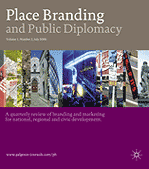How Israel used micro-marketing as an attempt to (re)position the country and improve its image abroad is the topic of a recent case study published in the academic journal ‘Place Branding and Public Diplomacy.’ Amir Grinstein, Associate Professor of Marketing at Northeastern University (USA) and VU Amsterdam (the Netherlands), is one of the authors of the case study. Here he tells us what led to this research and the main insights and lessons in connection with country branding and Israel.
Learn about:
- What led to this study on country branding in connection with Israel;
- Key insights and lessons learned;
- Country branding challenges and pitfalls to be aware of;
- How the research has impacted the author’s view on country branding and Israel;
- Other cases of country branding used to overcome negative image.
Amir, what motivated you to investigate country branding in connection with Israel?
I believe the Israeli case is a valuable example for place branding experts because Israel is a relatively young and very small country, which faces extreme geo-political challenges, and has been the subject of prolonged negative international media coverage. Further, it is a country of paradoxes: on the one hand, Israel is associated with a long-lasting regional conflict but on the other hand, it is the only democracy in the Middle East, known as the “start-up nation,” and is a leading country in humanitarian aid. A fascinating case for re-branding!
You just had your case study on Israel published in the journal Place Branding and Public Diplomacy. Can you share with us your key findings?
The article introduces a country (re)branding program that was based on a strategic, systematic, and decade-long “micro-marketing” campaign. The strategic process began in 2004. The article documents the program, including evidence on the creative and diverse market research that the re-branding team conducted over time, the re-branding strategy that was employed, and its implementation across six key domains (e.g., the environment, people, technology and science, lifestyle, culture and the arts, and international aid programs).
The article concludes with reporting positive changes in Israel’s brand performance and perception over time (2007–2015), as well as other country and industry-level indicators that demonstrate the effectiveness of the micro-marketing re-branding approach.
In your view, which are the main challenges with regard to using country branding to enhance a country’s image?
First, don’t think short-term. To make a long-lasting impact, the change process should be strategic and long-term, to prevail beyond any changing political leadership.
Second, don’t avoid or discount market research. The re-branding strategy and implementation program should be based on rigorous market research.
Third, don’t engage political leaders too much in the process but also do not ignore them. Ideally, the re-branding process should be a partnership between politicians, policy makers, and branding/marketing experts.
The government should have a professional and relatively autonomous team of marketing and branding experts to lead the re-branding program, so it is authentic and decisions are professional.
Which are the key insights from this project – lessons you’ve learned while conducting the research?
It is crucial that there is a passionate leadership–in government–that is willing to work with external professionals to make a change over a long period of time.
I can’t stress enough the importance of market research, using creative and diverse methods (for example, a novel type of focus groups, surveys, secondary data analysis) and conducting market research over time.
Once a re-branding strategy is in place, it is important to be systematic in the way you communicate your message.
How has your view on country branding and Israel changed since you conducted your research?
The research has exposed me to significantly different approaches towards country branding. Countries often want to change their image by launching a new campaign, logo, or by modifying communication. This approach might be successful in the short-run. But to be able to make a meaningful long-term change, a country re-branding program has to be holistic, deep, strategic, collaborative, and aimed at the long-run.
Another insight is that the cost of a re-branding program can be relatively reasonable through the use of micro-marketing: a customer-driven approach aimed at identifying and satisfying the needs of individual consumers or segments of consumers through personalized and customized marketing solutions and communications.
Apart from Israel, do you know other examples where country branding was used to overcome a negative image?
In the article we discuss other examples of countries with sub-optimal reputation that have been able to improve their brand, such as South Africa and Dubai.
Noteworthy, that in the Israeli case, the country brand is linked and can benefit from two very successful sub-brands associated with the country: the cities Tel-Aviv and Jerusalem. Those two very different cities attest to the paradox in the parent brand: while Jerusalem represents history, tradition and religion, the liberal and cosmopolitan Tel-Aviv (shown in the featured image above) has become a magnet for niche markets, such as the LGBTQA community, techies, clubbers, and lifestyle tourists.
Are there any other observations that you’d like to share with our readers?
Although in the research I tested a large set of performance indicators over time which, overall, demonstrate a positive correlation between the micro-marketing program and improvement in Israel’s brand, I do not claim a causal link. Other environmental factors may have contributed to the improvement in the perception of Israel in the world (for instance, compared to the current instability in the Middle East, Israel might be regarded a highly stable and safe country).
Thank you, Amir.
Connect with Amir Grinstein on LinkedIn or visit his page at Northeastern University. Access the article here.
Featured image: Tel Aviv
About Amir Grinstein
Amir Grinstein is Associate Professor of Marketing at Northeastern University and the Vrije Universiteit Amsterdam. His research and teaching interests are focused on two core issues: (1) the interface between marketing and society/public policy, especially various social and environmental contexts, such as the enhancement of “green”, healthy or other socially-desirable behaviors, and the effectiveness of de-marketing; (2) marketing strategy, including the study of strategic orientations and international marketing topics.
About Place Branding and Public Diplomacy
 Place Branding and Public Diplomacy is the first and only journal to concentrate on the practice of applying brand strategy and other marketing techniques and disciplines to the economic, social, political and cultural development of cities, regions and countries.
Place Branding and Public Diplomacy is the first and only journal to concentrate on the practice of applying brand strategy and other marketing techniques and disciplines to the economic, social, political and cultural development of cities, regions and countries.
The Place Brand Observer has teamed up with the journal’s publishers, Springer and Palgrave Macmillan, to share with you key research insights and findings.
Learn more about the journal here or read the stories of the journal’s editors, Robert Govers and Nick Cull.
Enjoyed this research insight and case study on how Israel used micro-marketing to improve country brand perceptions? Share and spread the word!



